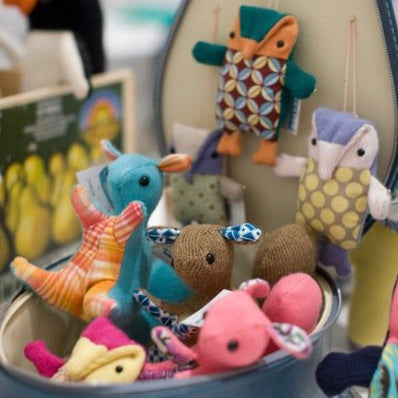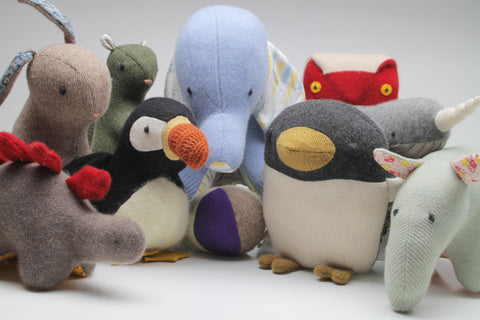***
How did you think to make a tapir? I think tapirs are so cute! They’re just such funny animals and have such a nice shape. And I thought this would be easy for my first foray into sewing.
Is this what you always intended to do? I thought I would be an illustrator; I just wanted to make a living making things. With the animals I can design them and I can work with my hands and see them from start to finish. It’s still a creative process and I don’t feel like I’m saying anything super profound, but I don’t feel the pressure to do that.
And you’re making something new from something old. I found a pair of pretty awesome cashmere pants — I didn’t even know they existed! [I’m] breathing new life into these beautiful cashmere pants.
How did you learn to sew? And how did that lead to making Sweatertoys? It was actually really hard for me because I’m a 2-D person, so to take a drawing of a tapir and somehow make it three-dimensional was a really bizarre thing for me. My mom taught me the sewing basics and was able to teach me how to start visualizing things in the third dimension. Then I found an animal at a thrift store, and I took it apart and turned it inside out. I feel like once you have a grasp of how that works, you can go on and pretty much make anything.
How do you craft a Sweatertoy? I used to go to the thrift store several times a week and pick out the best sweaters — literally go through the racks and pick the best colors and textures. In the beginning I was using acrylic and wool, but they just didn’t look right. Eventually I found a textile recycling company in New Jersey — it’s an amazing place if you like textiles — they’ve got vintage clothes, just bins and bins of different types of clothing, and it’s all labeled. There’s a whole box of Cosby sweaters. I clean them, and then can’t use certain parts that have stains or holes or pockets. So it kind of becomes this game of Tetris, trying to fit all of the pieces that I have for every pattern into these little areas that are actually usable.
So then when you go to the drawing board with a specific animal… After I design and develop a pattern (and there’s been multiple iterations for me to get it just right), I then put the part of the sweater that I can use on it and cut it out. After that, I sew it on my machine. I just take a bunch of animals and turn on a TV show and just stuff [with polyfill] for a few hours or a whole day. And then I stitch it up and I’ll put the eyes on. Lastly, when they have a face they get a name. So, this guy looked like Olivier to me and he became Olivier! And how would you describe the personalities of your pieces? A lot of them are a little quirky. Somebody described them once as “perfectly imperfect,” which I like. Because despite my best efforts, I’m making them individually by hand, so they’re never going to be absolutely perfect. As a kid I always picked out the one that looked a little bit sad, or a little bit like he wasn’t like the rest. So I think that’s what makes my animals a little bit different; they’re not quite perfect, but they’re loveable. Are they relatable to any real people in your life at all? Where do the names come from? [Laughs.] A lot of them come from family, and some are from a little neighborhood where I used to go because I liked the street names! It’s actually called Prospect Park, the area right outside Minneapolis. All of the blocks have cute names like Seymour, Sydney, Malcolm. Those guys make appearances quite often. Any pieces that you’re closest to? I hate to ask you to give preferential treatment... I’m not gonna beat around the bush, I like the penguin the best.At what point did the business move from gifts for friends to the made-in-Brooklyn Caitlin Wicker brand? In college, I was dating a gentleman who worked at the Walker Art Center in Minneapolis — it’s like a MoMA. He had brought an animal that I made [for] him to work and then the Walker decided they wanted to carry them in their shop, as a local artist spotlight type of thing. So that was pretty cool; even before I got good at them I was already having to make them for this museum and I was like, “Oh, God.” But it was still just a hobby at that time. When I moved to Chicago, I was working for a non-profit and doing this on the side, doing a craft fair here and there, just making extra money. And when we moved [to Brooklyn] it was going to be a side project. I got them in enough stores where I actually didn’t have time to find another job. I guess that’s kind of how it happened — it’s probably because I couldn’t get a job when I got here. It’s been good!
What originally brought you to NYC? My fiancé does film, and we moved here so he could be immersed in [New York’s] film culture; kind of a leap of faith, and the rest is history!
And how did you launch your brand in New York? I’m a bit shy when it comes to marketing myself. [My fiancé] was the one who basically — literally — pushed me into stores and said “Go talk to them! Tell them that you have this product.” So I owe a lot to him for helping me overcome my fear of talking to strangers.
How would you describe your relationship with New York and Brooklyn, and how the two have influenced you? I love it here — most of the time. The great thing about the city is that there’s all types of people here and it wouldn’t be the place it is without that. I love Brooklyn. Being from a smaller city it feels more neighborhood-y than Manhattan does to me. Being in New York, I think, really pushes you. There’s competition all around, and you really have to be motivated and passionate about what you do, and just get yourself out there. Otherwise somebody else is gonna come up and take your opportunity away.
Since moving to Brooklyn, have you teamed up with any other makers or shakers? I’ve met a lot of people doing craft markets; it’s such an insular community. If you’re sitting at a market all day you really get to know the people around you. I’ve had people suggest to me that I approach certain stores — “Oh, your stuff would really fit in there” — and I’ve done the same for other people. It ends up being a really supportive environment because we all know what it’s like to try to rely on this as your sole source of income, so we try to look out for each other. And I have made some pretty good friendships. Alan Dorsey makes amazing wooden things. He’s a cabinet maker and he’s also an artist so he does a lot of wood turnings; he ended up being one of our best friends.
What are some of the other tips and tricks of the trade that you’ve learned at the craft fairs and markets you’ve attended? Get to know your neighbors. It’s nice to have people on your side, looking out for you, having people to commiserate with, just to chat with.
What advice would you give to other makers, small business owners, or artisans? Just try to keep doing what you’re doing. It’s always good to refine your craft and get better at it and you also have to be a shameless self-promoter. I’m still learning how to do that, but you have to be your own best advocate. It seems pretty seldom that somebody is just discovered and they don’t have to do all the work themselves.
What’s next for Sweatertoys? I just got an embroidery machine, which is amazing. And I’ve been doing a lot of designs that I haven’t yet translated into the embroidery software. But I’m hoping to do some of that, work on some more mobiles; those kind of got sidelined—a lot of things just get sidelined, I guess, when you get busy. I’m kind of trying to develop both animals and home goods. Caitlin Wicker is the overarching brand. These are Sweatertoys by Caitlin Wicker.
Now the fated question….What is your New York State of Mind? I feel like this city kicks your butt into action. You can either let it get you down and you can get angry about it and frustrated, or you can just be optimistic. And I look around and I’ve got a wonderful fiancé, and a fat cat that sits on my lap. And we’ve made a nice life for ourselves here, so I just feel really lucky and optimistic about the future of Sweatertoys and my brand.



Leave a comment